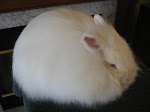I was just flipping the 'Rabbit Production' book today and found some interesting facts on Wool growth, Molting, and adjusting feed to manipulate holding time. This is a wonderful book that encompasses ALL aspects of rabbit raising, and I learn something new every time I read it:). Here are a few notes on angoras:
-"Females produce about 20% more wool than males"--p.441
-"Angoras reach their peak of wool production between 18 and 36 months of age. After three years of age, wool production and reproduction abilities begin a rapid decline."--p.441
-"There is an apparent antagonism between the amount of wool produced and reproductive performance"--P.441
-"Genetic selection is very important in the improvement of wool density and texture. Wool production and quality are highly heritable traits."--p.441
-"The rabbit's coat is prime when the hairs have a good sheen, are tight, and have attained their maximum length. The skin is white and the hair flows back into place evenly when the coat is rubbed from the rump to the shoulders".--p.105
-"Unprimeness is indicated by a dull, uneven coat and loose hair. The hair does not flow evenly when the coat is rubbed from the rump to the shoulders. Patches of new fibers can be seen, and these new fibers will appear in a growth pattern that varies from animal to animal. The skin of these new hair growth areas is dark and easily detected on rabbits with colored coats."--p.105
-"Heavy feeding of the young tends to cause the molt at an earlier age----Rabbits may be thrown into molt by disease, going "off feed", the sudden occurrence of unseasonable high temperatures, or other stresses."--p.106
-"Shedding first occurs on the sides of the rump and the thighs, followed by the back, then increasingly in areas down over the sides."--p.106
-"A high quality diet and high feed intake promote molting. The growth rate of hair is more rapid with a high nutrient intake, so the rate of turnover of hair is greater."--p.106
-"Restricted feeding of adult show animals reduces the amount of hair shedding and keeps the fur in prime condition for a longer period."--p.106
These facts seem to demonstrate what so many good conditioners of rabbits already know----that you cannot feed the same rabbit in exactly the same way year round regardless of climate or coat condition. A meticulous meat breeder that I know begins adding a top dressing to his rabbits' pellet ration as soon as a molt is over. He continues feeding this mix until just before the rabbits hit prime, and then he pulls them off it and gives them nothing but pellets and a pinch of horse sweet feed while they finish building and prime out completely. The withdrawal of grain mix at this point ensures that the growing cycle slows down and the rabbit holds prime condition longer, and the addition of sweet feed (only) makes the rabbits thirstier and improves flesh condition by increasing fluid intake.
Once a molt begins this breeder feeds his rabbits black oil sunflower seed to push them through it faster. He then begins the process all over again once molting is finished and the new coats begin. This same formula could also work with angoras, though the sunflower seed may not be necessary because we clip our rabbits and get rid of the excess wool that way. Pellet rations also need to be increased in the winter, restricted in summer, increased when the coat is coming in, and decreased when the coat peaks and begins to go out (or increased again as the coat slips in order to get through the molt faster).
These are just a few fascinating facts about wool and conditioning. Check them out this season and see how they work!
P.S. I also have some new pictures to post today after alot of grooming and clipping got done, and there are also 4 new litters to report from the previous week:). Nereida/Pierre produced a litter of 8 kits---2 Black, 1 Fawn, and 5 REW, and Devaki/Dijon also produced a litter of 8 (with 1 stillborn) including 1 Black, 1 Chestnut, 3 Tort, 1 Fawn, and 1 REW. Neva and Sadako both had litters as well but there were very, very small, LOL! Neva gave birth to 1 Pearl and 1 Tort, and Sadako had 2 Pearls and 1 REW (as far as I can tell so far). I fostered Neva's babies to Sadako and rebred her again today to see if I could get a few more babies out of her before she retires from breeding, and I also bred Echo to Pierre once again in the hopes of getting some more Sables. Tomorrow I will breed Pascha to Pierre also for an additional litter in June.
Here are some pictures of Oomi that I took this afternoon after grooming. The wind was blowing her coat all over the place except for one picture where it looked neat (LOL), and it looks as though she will make probably it to the Harford, PA show and maybe even Frankfort if she stays on feed and isn't slipping too horribly:(.



And this, below, is a picture of Juno who just weaned a litter 2 weeks ago (!!) and is already ready to go back to the showtable:-):-). She is not in full coat at the moment but it looks as though she will definitely be able to enter PA this weekend and Frankfort on June 6, after which I will shear and breed her again for another great litter (I hope:)).
























No comments:
Post a Comment